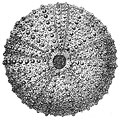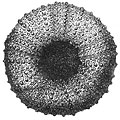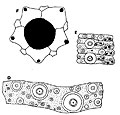The Echinoid Directory
Contributed by Andrew Smith, September 2006
Pseudorthopsis Sanchez Roig, 1949, p. 37
| Diagnostic Features |
|
|---|---|
| Distribution | Late Cretaceous (Maastrichtian); Cuba. |
| Name gender | feminine |
| Type | Echinopedina cubensis Cotteau, 1881, p. 9, by original designation. |
| Species Included | Only the type species. |
| Classification and/or Status | Acroechinoidea, Carinacea, Orthopsidae. Monotypic |
| Remarks | Differs from Orthopsis only in having pore-pairs arranged in oblique triads at the ambitus with every third pore-pair distinctly indented rather than a single series. Sanchez Roig, M. 1949. Los equinodermos fosiles de Cuba. Paleontologia Cubana 1, 330 pp, 50 pls. Smith, A. B. & Jeffery, C. H. 2000. Maastrichtian and Palaeocene echinoids: A key to world faunas. Special Papers in Palaeontology 64, 1-404. Cotteau, G. 1897. Descripcion de los equinoides fosiles de la Isla de Cuba. Boletin de la Comision del Mapa Geologico de Espana 22 (2), 1-98, pls 1-29. |




